The Power of Projects

The concept of projects has been on my mind lately.
They're extremely powerful, somewhat of a secret weapon for creators. Projects open doors, spark new growth in your audience and your revenue, and give you something to focus your efforts on each day.
Yet, most creators - myself included - get into a creative rhythm and routine of daily posting, weekly core content like a blog, newsletter, YouTube video, or podcast, and they maintain that day in and day out.
Projects can seem daunting, and there are plentiful excuses not to attempt something big. But these creators miss out on all of the benefits a creative project can bring into their business.
Today I'll talk about two new projects (!!) that I've been working on and am starting, and how you can use my approach on your own creative projects, including:
- How to choose a project
- How to achieve multiple outcomes from one project
- How to use projects to collaborate with other creators
- How to work on multiple projects at the same time
"The desire to create is one of the deepest yearnings of the human soul." -- Dieter F. Uchtdorf
How to choose a creative project
I've spoken and written a bunch about the Craftsman mindset, a term coined by Cal Newport in his book So Good They Can't Ignore You.
I've borrowed the term (and built an entire business around that concept) and use this same approach when I choose a project.
Any new project starts with this question:
What is the outcome?
Do I want to create a body of work? Have a completed project at the end? Grow my audience? Bring in more revenue? Create a new revenue stream?
Any and all of these outcomes are valid and a project can accomplish more than one, as I'll talk about below.
Ideas for projects often stem from my morning pages - thirty minutes of freewriting that I do every morning before I start my day. I write about what I'm working on, what I'm thinking about, what I want, what's working and not working, and sometimes just random thoughts.
Every so often, though, a spark of an idea, the beginning of a project starts to form over days and weeks.
But before I dive in, I always think about the outcome, or outcomes, that I care about, as those outcomes are what inform the way I structure the project.
I often have as many as 10-12 ideas floating around at any given time, so every quarter - at least - I'll go through my current list and choose the one that I'm most excited about that aligns with the outcomes that I'm after.
That's important, because in order for a project to move my business forward, it needs to align with the outcomes that matter right now. I rarely create just because I feel like it, because I've embodied this Craftsman approach to creative work. And, as you'll see, it's served me well.
How to achieve multiple outcomes from one project
The next step is how to structure the project to achieve these outcomes.
Take write a book as a project. There are many ways you can get a book written.
You can write it yourself, you can do a blog-to-book method like I did for my last two books, you can hire a ghostwriter, you can pull transcripts from video interviews and edit it into a book... the list goes on.
The outcomes you're after dictate the way you create the project.
For my last book, I wanted to grow my audience and create a remarkable project that attracted the right type of creator into my world, and kick off my work as a creative entrepreneur.
Because of these outcomes - specifically I wanted to reach 2,500 followers and $10,000 in revenue - I decided to write the book in public, so that I was showing up every day online for the people the book was for. I knew that I would need many "touch points" with this audience to show them that I'm serious and that I'm making something that will benefit them.
The result? Over $15,000 in revenue - a combination of book sales, community memberships, and consulting gigs that stemmed from the project, and I added 500 new people to my email list, bringing it to just over 2,000 by the time the book was launched.
The way you create the project is how you achieve multiple outcomes for you and your business.
How to use projects to collaborate with other creators
I wrote about collaboration two weeks ago - https://blog.craftsmancreative.co/how-to-collaborate-with-bigger-creators/ - but it's important to bring it up here in the context of projects.
Being able to say "I'm working on a project..." in a dm or an email message to another creator gives you a huge advantage over "Hey, I'd love to collaborate with you!"
Of course you would... is what the other creator is often thinking.
Every day I get 2-3 cold messages on LinkedIn from people offering their services. Of course you'd like to hop on a call, of course you'd like me to ceck out your site, of course...
It's completely one-sided!
[Delete]
Instead, when you approach a creator with "I'm working on a project...", all of a sudden they lean in because you're inviting them to be part of a project... There's something impressive or even mysterious about that word by itself!
It's a good moment to share one of the new projects that launches this week, because I used this exact approach to land a creator with 65 times the Twitter audience and 10x the email subscribers that I do.
A few months ago I reached out to Joe Pulizzi from TheTilt.com with this email:
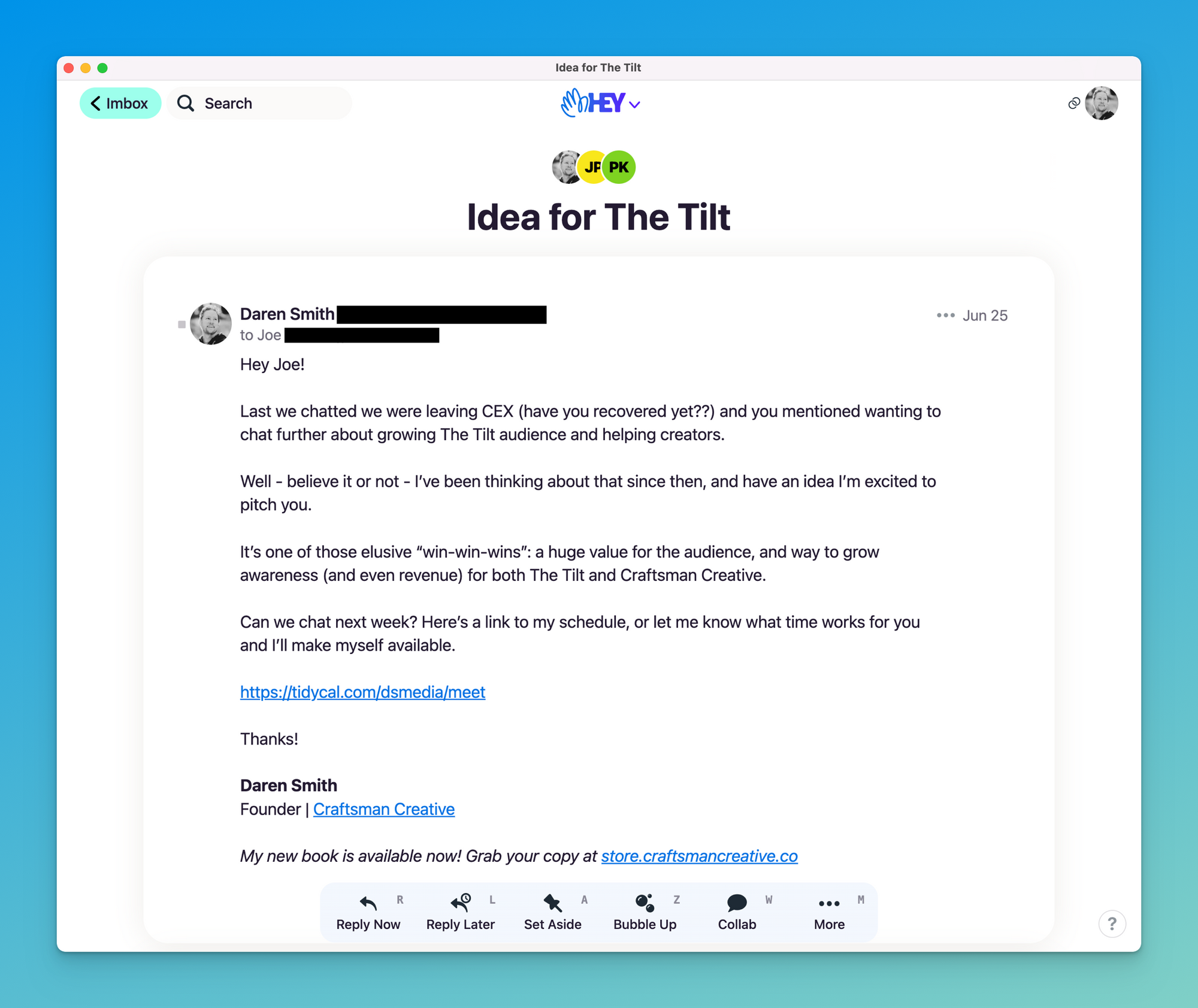
(Yes, I failed to use "project" and used "idea" instead. But hey, still worked!)
Note how I highlighted the outcomes, but left the project itself vague.
I sent that email on June 25, Joe responded on June 27 with a "yes, let's chat", and we had a call on July 13 while I was out in South Africa, and I pitched him an idea for a podcast project - a 10-episode season documenting the journey from 0-10k, both audience and monthly revenue.
Joe loved the idea, but was hesitant because of his busy schedule. (He was also kindly cautious about my schedule, as I was out producing a movie on the other side of the world...)
We emailed back and forth for a few weeks, and Joe expressed a desire to do the podcast as long as we could presell the sponsors to make it a revenue-generating project from the start. Brilliant!
Here's a version of what he sent out to those sponsors:
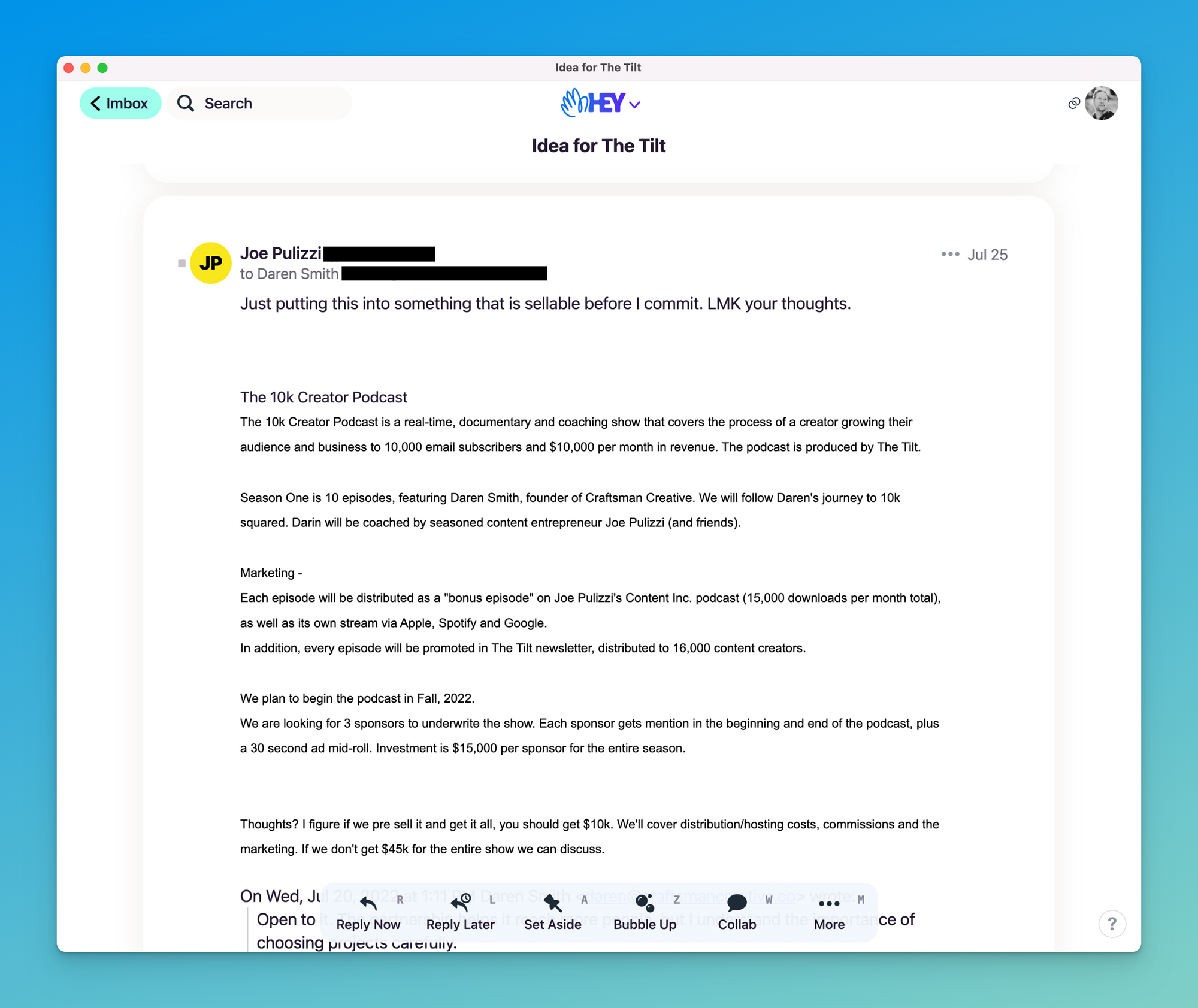
Pretty cool, right?
That was a month later, July 25. Two weeks later, I got this email from Joe, with the subject, "start getting ready":
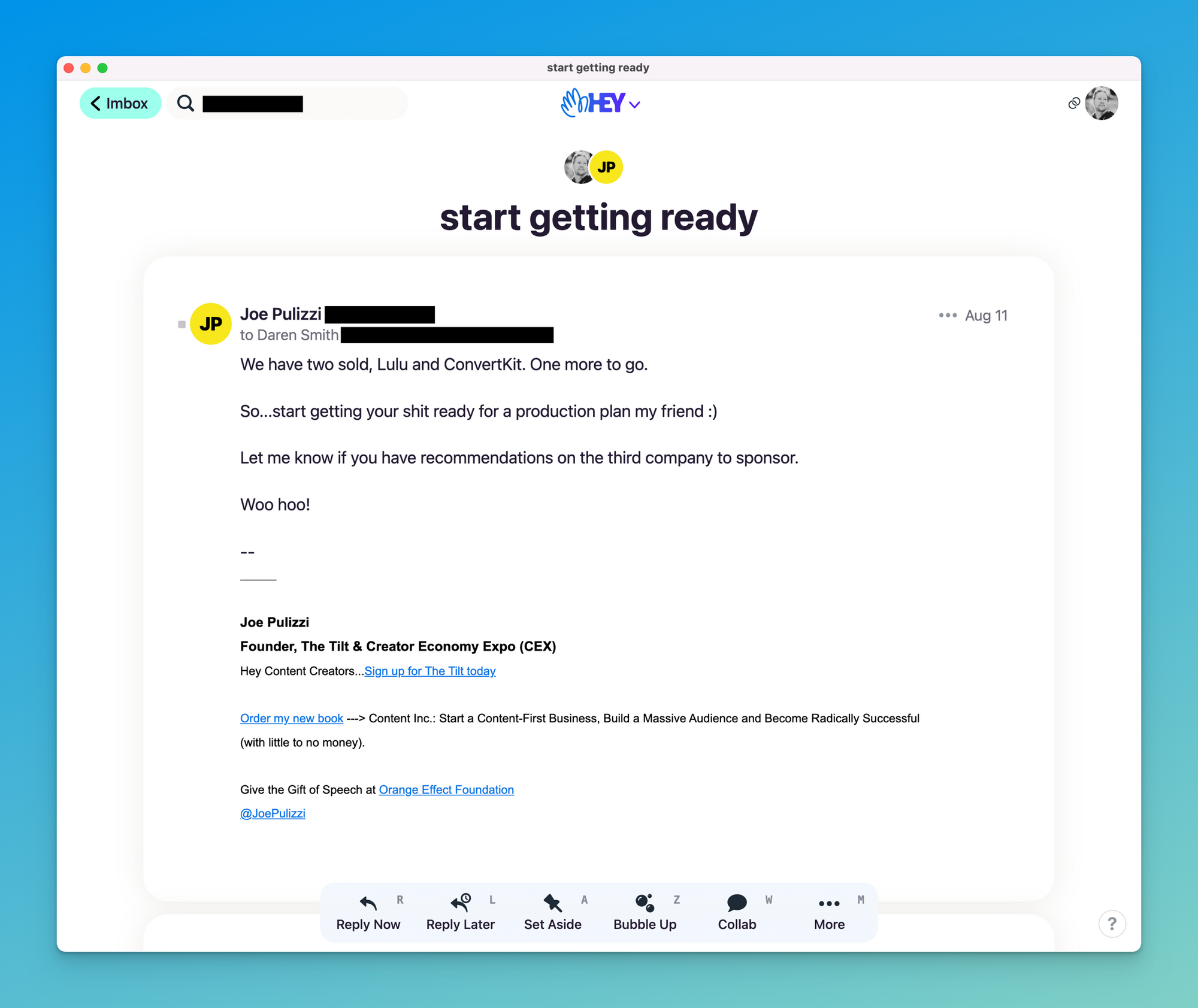
That third sponsor - Streamyard - came in shortly after.
Yes, the first three sponsors we approached for three available sponsor slots all said "yes!"
This is the power of a project!
Could I have done this on my own? Probably, but not to the same extent or in the same amount of time. I don't have hundreds of thousands of social followers, an email list of 16,000 people, or a podcast that already gets 20,000 downloads a month.
Since that email 6 weeks ago, we've recorded the first four episodes of The 10k Creator, and the first episode comes out on Wednesday, on Joe's Content, Inc. podcast feed.
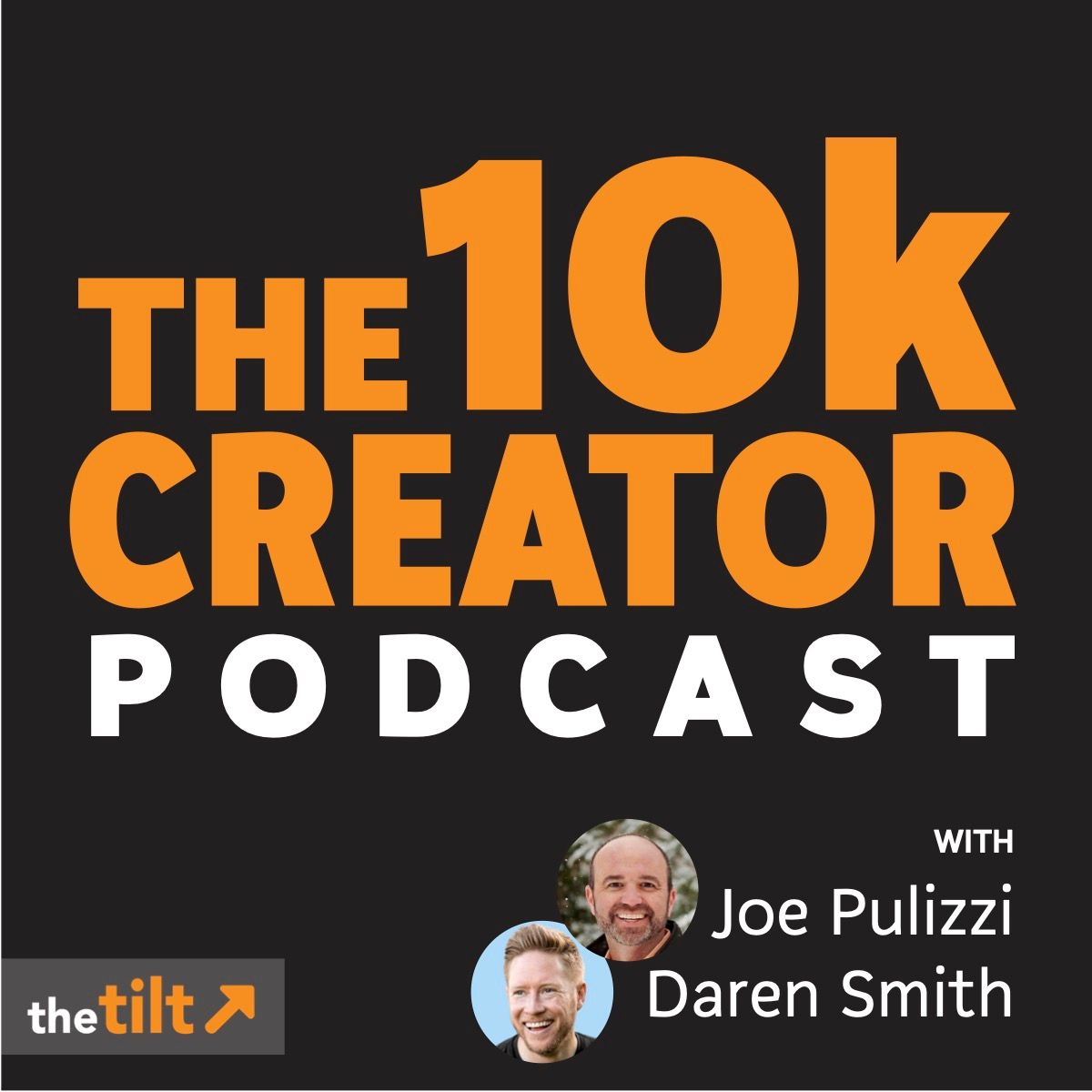
We made it for you. I hope you love it!
You can listen to the announcement in this episode of the Content, Inc. podcast:
https://www.contentinc.io/tent-pole-content-projects-a-mustplus-a-new-show-360/
Episode 1 comes out on Wednesday
How to work on multiple projects at the same time
The short answer: don't.
I've tried time and time again to do multiple projects in a given day, week, or even month.
Then I get to that day, week, or month and have not much to show for it.
A better approach - that I've discovered mainly through trial and error - is to have one main project at any given time, one project that you're prepping to work on next, and then one or more projects that are in "maintenance mode".
What that looks like for me when I'm in full-time creator mode, i.e. not producing a movie on the other side of the world, is a day like this:
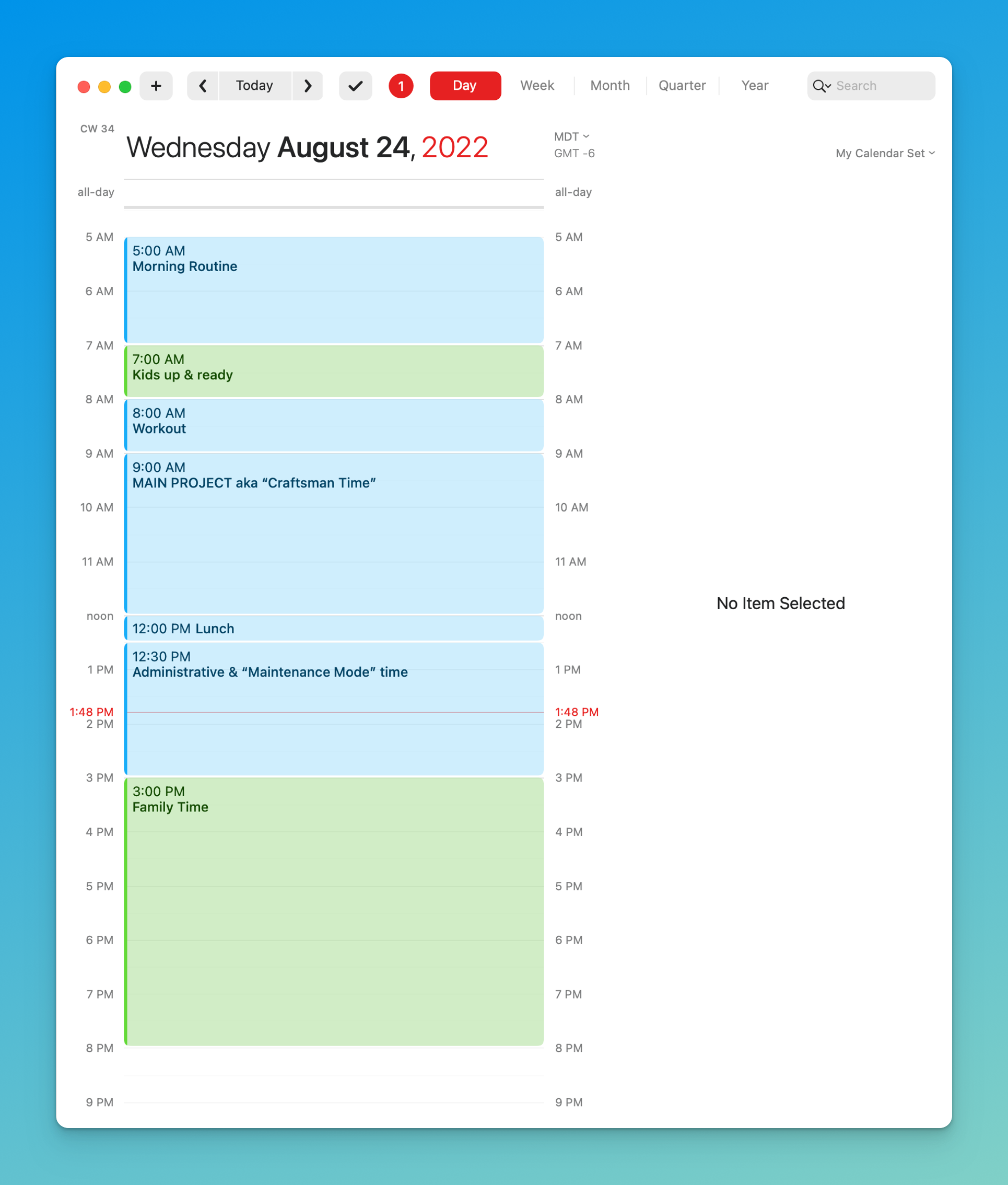
When I'm working on a big project like a feature film, I don't do anything but that project, so all of my "Craftsman time" and "maintenance time" goes out the window... but this is my ideal, dream schedule when I'm in full-time creator mode.
I can't muster more than about 3 hours of "deep work" (another term from Cal Newport) in a day, and can only do that much if I've been disciplined with getting up early, doing my whole morning routine, and working out/moving first.
Some days are 30-60 minutes, but most are 2-3 hours of "Craftsman time".
I work on the same project every day during that block of time until it's done. If there are tasks I need to do on other projects or in my business - paying contractors, accounting, writing & scheduling Tweets, etc - that happens in the afternoon.
This approach has worked well for me, and in the last 12 months I've produced two feature films, written and published a book, produced and launched two new courses, started a creator membership community, sold and started a new podcast, traveled to NYC with my whole family and Cape Town with my wife at the end of filming, and have influenced hundreds of creators along the way.
All that is to say that this project-based approach works. So, give it a try.
Wait, didn't you say you were announcing two projects?
Yes. But this email is long enough already. So, if you're a filmmaker, you should go check out indiefilmbudgets.com, and if you're a creator, you should head over to Twitter where I'll be documenting the creation of this project over the next month until launch!
LINKS FOR THIS WEEK
Check out the announcment for the new podcast over at Content, Inc.
https://www.contentinc.io/tent-pole-content-projects-a-mustplus-a-new-show-360/
Loved this thread about principles Ryan Holiday used to grow a 500,000 reader email list for Daily Stoic
September 15th 2022
|
NEWSLETTERS YOU SHOULD CHECK OUT:
Some of my favorite newsletters are also on the new SparkLoop partner network, and I'm excited to be able to share them here:
The Bootstrapped Founder by Arvid Kahl
Every Friday, the Bootstrapped Founder Newsletter features proven tactics to help you launch, build, and grow your business based on the experiences of Arvid Kahl, author of Zero to Sold and founder of FeedbackPanda. You’ll learn how to build an engaged audience, how to monetize it, and how to leverage “building in public” to become a recognized expert in your field.
If you want sketchy “hacks,” it’s not for you.
But if you want honest, practical, effective advice to build a real business serving real people, you’re going to love it.
The Playbook by Unemployable
I've been a member of Unemployable from Brian Clark for about a year now and it's one of the best newsletters / communities that I've found on my creator journey.
Brian knows his stuff, having founded Copyblogger and a number of other 7- and 8-figure businesses in the creator economy.
As I like to say, learn from the people who have the success that you want, and are teaching people how to achieve it.
Creator Wizard from Justin Moore
Justin is one of the most prolific creators I know. He has been a YouTuber and blogger, built a sponsor agency to work with other influencers, and more recently is educating people on sponsorships and brand deals through his Brand Deal Wizard cohort and Gifted to Paid course.
His newsletter keeps me up to date with what's happening in the creator space, and is one of the few newsletters that can actually make you money because he includes actual brand deals that are available each week.
For The Interested from Josh Spector
There may not be another individual who has done more for the growth of my newsletter than Josh. He's kindly shared links to my blog posts and book which has sent thousands of his readers my way, and I'm happy to return the favor as his newsletter is a must-read.
Every Sunday he sends his main newsletter, but then you get quick hits each morning the rest of the week. If you're a creator or artist, you need to be reading this one every week.


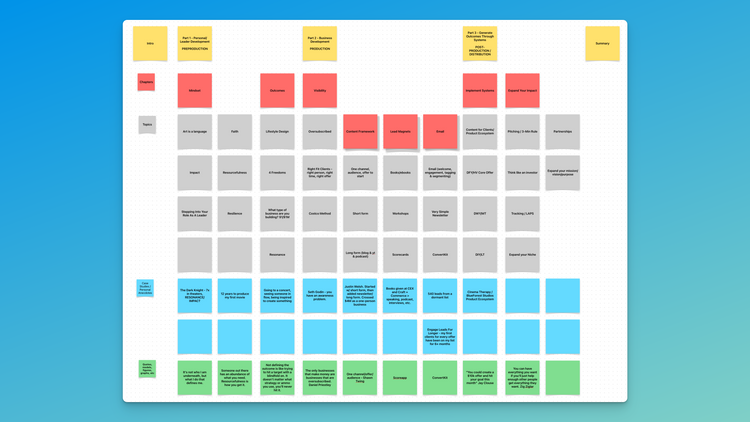




Member discussion